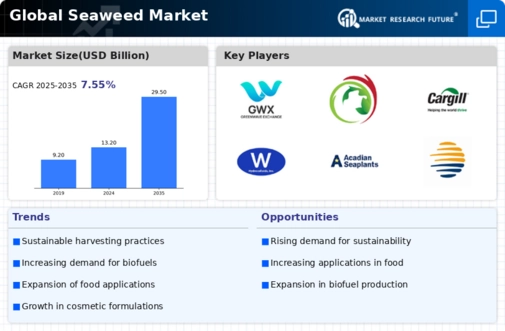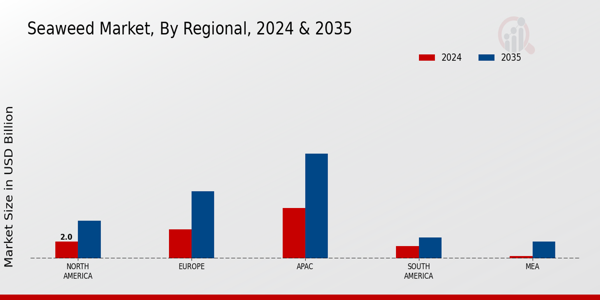Market Growth Projections
The Global Global Seaweed Market Industry is projected to experience robust growth, with estimates indicating a market value of 13.2 USD Billion in 2024 and a potential increase to 29.5 USD Billion by 2035. This growth trajectory suggests a compound annual growth rate (CAGR) of 7.55% from 2025 to 2035. Such projections highlight the increasing recognition of seaweed's versatility and sustainability, as well as its expanding applications across various sectors. The market's potential is further underscored by ongoing innovations and rising consumer demand for eco-friendly products.
Innovations in Seaweed Processing
Innovations in seaweed processing technologies are transforming the Global Global Seaweed Market Industry, enhancing product quality and expanding applications. Advanced extraction methods and processing techniques enable the production of high-quality seaweed derivatives, such as alginates and carrageenan, which find applications in various sectors, including food and pharmaceuticals. These innovations not only improve efficiency but also reduce waste, aligning with sustainability goals. As a result, the market is poised for growth, with a projected CAGR of 7.55% from 2025 to 2035, reflecting the increasing adoption of these technologies.
Government Support and Regulations
Government support and favorable regulations play a crucial role in the Global Global Seaweed Market Industry, fostering growth and innovation. Many countries are implementing policies that encourage sustainable aquaculture practices and the cultivation of seaweed. This support often includes financial incentives, research funding, and infrastructure development. For instance, various governments are recognizing the potential of seaweed in carbon sequestration and as a renewable resource, which further stimulates investment in the sector. Such initiatives are likely to enhance the market's growth trajectory, ensuring a robust future for the industry.
Health Benefits and Nutritional Value
The Global Global Seaweed Market Industry benefits significantly from the growing recognition of seaweed's health benefits and nutritional value. Rich in vitamins, minerals, and antioxidants, seaweed is increasingly incorporated into diets worldwide. The rising trend of plant-based diets and functional foods has led to a greater acceptance of seaweed as a superfood. This trend is likely to contribute to the market's expansion, with projections indicating a market value of 29.5 USD Billion by 2035. As health-conscious consumers seek nutritious alternatives, the demand for seaweed-based products continues to rise.
Diverse Applications Across Industries
The Global Global Seaweed Market Industry is characterized by its diverse applications across multiple sectors, including food, agriculture, cosmetics, and pharmaceuticals. Seaweed serves as a natural thickening agent in food products, a biofertilizer in agriculture, and a source of bioactive compounds in cosmetics. This versatility not only broadens the market's appeal but also mitigates risks associated with reliance on a single sector. As industries increasingly recognize the benefits of incorporating seaweed into their products, the market is expected to witness substantial growth, driven by innovation and consumer demand.
Rising Demand for Sustainable Products
The Global Global Seaweed Market Industry experiences a notable surge in demand for sustainable products, driven by increasing consumer awareness regarding environmental issues. Seaweed, recognized for its minimal ecological footprint, serves as a viable alternative to traditional agricultural products. This shift is reflected in the market's projected growth, with an estimated value of 13.2 USD Billion in 2024. As consumers increasingly prioritize sustainability, industries such as food, cosmetics, and pharmaceuticals are integrating seaweed into their supply chains, further propelling the market forward.


















